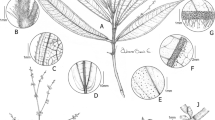Abstract
We describe Pterolepis xaxa (Melastomateae, Melastomataceae), a new species collected in “caatinga rupestre” at Licínio de Almeida, Bahia, Brazil. Pterolepis xaxa resembles the recently described Pterolepis haplostemona, both representing the only two species in the genus that are haplostemonous (i.e., with the stamens equal in number to the petals). Apart from flowers with a single whorl of stamens, P. xaxa can also be recognized by intercalycine projections consisting of a very short central axis topped with 2–3 trichomes, and white petals (vs. intercalycine projections lacking trichomes at the apex and magenta or lilac petals in P. haplostemona).


Similar content being viewed by others
Literature cited
Almeda F. & O. R. Robinson. 2011. Systematics and phylogeny of Siphanthera (Melastomataceae). Systematic Botany Monographs 93: 1–101.
Almeda F. & A. B. Martins. 2015. Pterolepis haplostemona (Melastomataceae): a new serpentine endemic from Goiás, Brazil. Phytotaxa 201: 233–238. https://doi.org/10.11646/phytotaxa.201.3.8.
Almeda F. & R. Pacifico. 2018. Neotropical Poteranthera (Melastomataceae: Microlicieae) revisited. Systematic Botany 43: 552–556. https://doi.org/10.1600/036364418X697274.
Campos, L., M. L. S. Guedes, P. Acevedo-Rodríguez & N. Roque. 2017. Contributions to the floristic and vegetation knowledge of Espinhaço Septentrional, Bahia, Brazil. Brazilian Journal of Botany 40: 427–437. https://doi.org/10.1007/s40415-016-0347-y.
Cogniaux, C. A. 1885. Pterolepis. In: C. F. P. Martius et al. (eds.), Flora brasiliensis 14 (3): 259–288. Frid. Fleischer, Leipzig.
Goldenberg, R., K. C. Silva-Gonçalves & F. A. Michelangeli. 2020 onward. Pterolepis. In: Flora e Funga do Brasil. Jardim Botânico do Rio de Janeiro, Rio de Janeiro. https://floradobrasil.jbrj.gov.br/FB9856. (Accessed: 24 October 2022).
IUCN. 2012. IUCN Red List Categories and Criteria: Version 3.1. Second edition. IUCN, Gland, Switzerland and Cambridge, UK.
IUCN. 2019. Guidelines for using the IUCN Red List Categories and Criteria. Version 14. Prepared by the Standards and Petitions Subcommitee. Downloadable from http://www.iucnredlist.org/documents/RedListGuidelines.pdf. Accessed 5 June 2023.
Jesus, J. C., R. Romero & N. Roque. 2018. Two new species of Microlicia (Melastomataceae) from the Septentrional Espinhaço, Bahia, Brazil. Phytotaxa 343: 240–248. https://doi.org/10.11646/phytotaxa.343.3.4.
Judd, W. S., L. C. Majure, F. A. Michelangeli, R. Goldenberg, F. Almeda, D. S. Penneys & R. D. Stone. 2022. Morphological variability within Melastomataceae (Myrtales), including a discussion of associated terminology. Pp. 45–85 in: Goldenberg, R., F. A. Michelangeli & F. Almeda (eds.) Systematics, Evolution, and Ecology of Melastomataceae. Springer, Cham. https://doi.org/10.1007/978-3-030-99742-7_3.
Loeuille, B. & N. Roque. 2017. Maschalostachys, a new genus of Vernonieae (Asteraceae) from Brazil. Phytotaxa 295: 35–48. https://doi.org/10.11646/phytotaxa.295.1.3.
Michelangeli, F. A., P. J. F. Guimaraes, D. S. Penneys, F. Almeda & R. Kriebel. 2013. Phylogenetic relationships and distribution of New World Melastomeae (Melastomataceae). Botanical Journal of the Linnean Society 171: 38–60. https://doi.org/10.1111/j.1095-8339.2012.01295.x.
Michelangeli, F. A., J. S. Murillo-Serna & H. Mendoza-Cifuentes. 2022. The Cyphostyleae, a small tribe rich in rare characters in the family. Pp. 307–319 in: Goldenberg, R., F. A. Michelangeli & F. Almeda (eds.) Systematics, Evolution, and Ecology of Melastomataceae. Springer, Cham. https://doi.org/10.1007/978-3-030-99742-7_14.
Penneys, D. S., F. Almeda, M. Reginato, F. A. Michelangeli, R. Goldenberg, P. W. Fritsch & R. D. Stone. 2022. A new Melastomataceae classification informed by molecular phylogenetics and morphology. Pp. 109–165 in: Goldenberg, R., F. A. Michelangeli & F. Almeda (eds.) Systematics, Evolution, and Ecology of Melastomataceae. Springer, Cham. https://doi.org/10.1007/978-3-030-99742-7_5.
Renner S. S. 1993. The widespread occurrence of anther destruction by Trigona bees in Melastomataceae. Biotropica 15: 251–256.
Renner S. S. 1994. A revision of Pterolepis (Melastomataceae: Melastomeae). Nordic Journal of Botany 14: 73–104. https://doi.org/10.1111/j.1756-1051.1994.tb00575.x.
Romero R. 2009. 24. Pterolepis (DC.) Miq. In: M.G.L. Wanderley et al. (eds.) Flora Fanerogâmica do Estado de São Paulo 6: 118–120. FAPESP, São Paulo.
Roque, N. & F. A. Santana. 2014. A New Species for a Monotypic Genus: Anteremanthus (Asteraceae: Vernonieae). Systematic Botany 39: 656–661. https://doi.org/10.1600/036364414X680771.
Ule, E. 1908. Beiträge zur Flora von Bahia. I. Botanishe Jahrbücher für Systematik, Pflanzengeschichte und Pflanzengeographie 42: 232–236.
Ulloa Ulloa, C., F. Almeda, R. Goldenberg, G. Kadereit, F. A. Michelangeli, D. S. Penneys, R. D. Stone & M. C. Veranso-Libalah. 2022. Melastomataceae: Global Diversity, Distribution, and Endemism. Pp. 3–28 in: Goldenberg, R., F. A. Michelangeli & F. Almeda (eds.) Systematics, Evolution, and Ecology of Melastomataceae. Springer, Cham. https://doi.org/10.1007/978-3-030-99742-7_1.
Veranso-Libalah, M. C., R.D. Stone & G. Kadereit. 2020. Towards a complete phylogeny of African Melastomateae: systematics of Dissotis and allies (Melastomataceae). Taxon 69: 946–991. https://doi.org/10.1002/tax.12317.
Veranso-Libalah, M. C., R. D. Stone, G. Kadereit, & P. J. F. Guimarães. 2022. Systematics and Taxonomy of the Tribe Melastomateae. Pp. 429–463 in: Goldenberg, R., F. A. Michelangeli & F. Almeda (eds.) Systematics, Evolution, and Ecology of Melastomataceae. Springer, Cham. https://doi.org/10.1007/978-3-030-99742-7_21.
Wurdack J. J. 1981. Certamen Melastomataceis XXXIII. Phytologia 49: 147–158.
Wurdack J. J. 1983. Certamen Melastomataceis XXXVI. Phytologia 53: 121–137.
Wurdack J. J. 1986. Atlas of hairs for Neotropical Melastomataceae. Smithsonian Contributions to Botany 63: 1–80. https://doi.org/10.5479/si.0081024X.63.
Acknowledgements
We thank Natanael Nascimento dos Santos for the drawings, and Frank Almeda and an anonymous reviewer for the suggestions on a previous version of the text. JCJ, NR and RG received grants from CNPq/Brazil (masters degree for the former and “produtividade em pesquisa” for the other two, respectively #311379/2022-2 and #310912/2021-0). This work was supported in part by the NSF (DEB-2001357 and 2002270).
Author information
Authors and Affiliations
Contributions
RG, NR and FAM conceived the study, provided the morphological description and taxonomic analyses, and contributed to writing; JCJ collected the plants, took the photos and helped preparing the illustration.
Corresponding author
Ethics declarations
Competing Interests
The authors have no competing interests to declare that are relevant to the content of this article.
Rights and permissions
Springer Nature or its licensor (e.g. a society or other partner) holds exclusive rights to this article under a publishing agreement with the author(s) or other rightsholder(s); author self-archiving of the accepted manuscript version of this article is solely governed by the terms of such publishing agreement and applicable law.
About this article
Cite this article
Goldenberg, R., de Jesus, J.C., Roque, N. et al. Pterolepis xaxa (Melastomateae, Melastomataceae), a new haplostemonous species from Bahia, Brazil. Brittonia 75, 300–306 (2023). https://doi.org/10.1007/s12228-023-09747-x
Received:
Revised:
Accepted:
Published:
Issue Date:
DOI: https://doi.org/10.1007/s12228-023-09747-x




